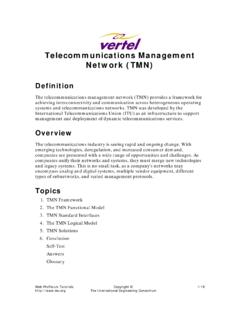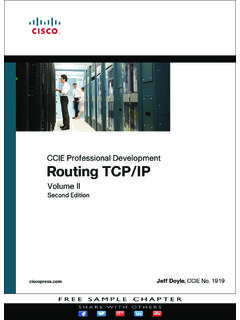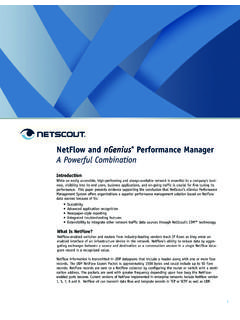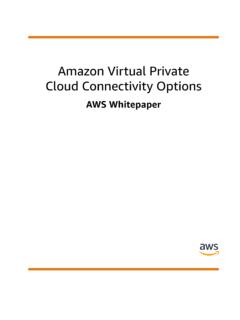Transcription of Generalized Multiprotocol Label Switching (GMPLS)
1 Web ProForum Tutorials Copyright The International Engineering Consortium 1/27 Generalized Multiprotocol Label Switching ( gmpls ) Definition and Overview The premise of Multiprotocol Label Switching ( mpls ) is to speed up packet forwarding and provide for traffic engineering in Internet protocol (IP) networks. To accomplish this, the connectionless operation of IP networks becomes more like a connection-oriented network where the path between the source and the destination is precalculated based on user specifics. To speed up the forwarding scheme, an mpls device uses labels rather than address matching to determine the next hop for a received packet.
2 To provide traffic engineering, tables are used that represent the levels of quality of service (QoS) that the network can support. The tables and the labels are used together to establish an end-to-end path called a Label switched path (LSP). Traditional IP routing protocols ( , open shortest path first [OSPF] and intermediate system to intermediate system [IS IS]) and extensions to existing signaling protocols ( , resource reservation protocol [RSVP] and constraint-based routing Label distribution protocol [CR LDP]) comprise the suite of mpls protocols. Generalized mpls ( gmpls ) extends mpls to provide the control plane (signaling and routing) for devices that switch in any of these domains: packet, time, wavelength, and fiber.
3 This common control plane promises to simplify network operation and management by automating end-to-end provisioning of connections, managing network resources, and providing the level of QoS that is expected in the new, sophisticated applications. This tutorial focuses on the issues that gmpls resolves in providing a common control plane to operate across dissimilar network types ( , packet, time division multiplexing [TDM], and optical). Initially, a brief overview of mpls and its evolution to gmpls is given. Next, a summary of gmpls protocols and important extensions is presented. In-depth coverage of the issues is then provided.
4 At the end, some of the current outstanding issues in gmpls are explored. Web ProForum Tutorials Copyright The International Engineering Consortium 2/27 Topics 1. introduction 2. Evolution from mpls 3. gmpls Issues and their Resolutions 4. gmpls Outstanding Issues Self-Test Correct Answers Glossary 1. introduction The emergence of optical transport systems has dramatically increased the raw capacity of optical networks and has enabled a slew of new, sophisticated applications. For example, network-based storage, bandwidth leasing, data mirroring, add/drop multiplexing [ADM], dense wavelength division multiplexing [DWDM], optical cross-connect [OXC], photonic cross-connect [PXC], and multiservice Switching platforms are some of the devices that may make up an optical network and are expected to be the main carriers for the growth in data traffic.
5 The diversity and complexity in managing these devices have been the main driving factors in the evolution and enhancement of the mpls suite of protocols to provide control for not only packet-based domains, but also time, wavelength, and space domains. gmpls further extends the suite of IP-based protocols that manage and control the establishment and release of Label switched paths (LSP) that traverse any combination of packet, TDM, and optical networks. An important economic impact of gmpls is providing the ability to automate network resource management and the service provisioning of end-to-end traffic-engineered paths.
6 Service provisioning has been a manual, lengthy, and costly process , synchronous optical network (SONET) based ring networks. To manually provision an end-to-end high-speed connection, a carrier must determine which SONET rings the connection traverses and provision bandwidth on each ring manually. If any ring is at full capacity, the carrier must find an alternative ring path or upgrade the capacity of a ring and propagate the information to all sites manually. These are very time-consuming processes and can take months. The deployment of gmpls based nodes allows carriers to automate the provisioning and management of the network and promises to Web ProForum Tutorials Copyright The International Engineering Consortium 3/27 lower the cost of operation by several orders of magnitude (days or even minutes instead of weeks or months).
7 2. Evolution from mpls mpls Background and Operation mpls extended the suite of IP protocols to expedite the forwarding scheme used by IP routers. Routers, to date, have used complex and time-consuming route lookups and address matching schemes to determine the next hop for a received packet, primarily by examining the destination address in the header of the packet. mpls has greatly simplified this operation by basing the forwarding decision on a simple Label . Another major feature of mpls is its ability to place IP traffic on a defined path through the network. This capability was not previously possible with IP traffic.
8 In this way, mpls provides bandwidth guarantees and other differentiated service features for a specific user application (or flow). Current IP based mpls networks are capable of providing advanced services such as bandwidth-based guaranteed service, priority-based bandwidth allocation, and preemption services. For each specific service a table of forwarding equivalence class (FEC) is created to represent a group of flows with the same traffic-engineering requirements. A specific Label is then bound to an FEC. At the ingress of an mpls network, incoming IP packets are examined and assigned a " Label " by a Label edge router (LER).
9 The labeled packets are then forwarded along an LSP, where each Label -switched router (LSR) makes a Switching decision based on the packet's Label field. An LSR does not need to examine the IP headers of the packets to find an output port (next hop). An LSR simply strips off the existing Label and applies a new Label for the next hop. The Label information base (LIB) provides an outgoing Label (to be inserted into the packet) and an outgoing interface (based on an incoming Label on an incoming interface). Signaling to establish a traffic-engineered LSP is done using a Label distribution protocol that runs on every mpls node.
10 There are a number of different Label -distribution protocols. The two most popular RSVP traffic engineering (RSVP TE) and CR LDP. RSVP TE is an extended version of the original RSVP to piggyback and distribute labels on its messages and to provide traffic-engineering capability. CR LDP was designed specifically for this purpose. Figure 1 shows the flow of Label distribution that is carried out by the downstream LER (in this case LER2) while the LSP flow is the reverse. Web ProForum Tutorials Copyright The International Engineering Consortium 4/27 Figure 1. Figure 1: An mpls -Based Network The mpls framework includes extensions to existing IP link-state routing protocols.












